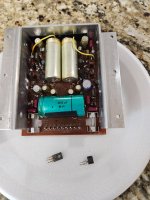Working presently on a Telefunken Magnetophon m3002 r2r. Anybody out there familiar with the audio output amps in these? The amplifier board fried the output transistors, so I can't power up until I locate the issue. One item showed up on resistance checks, R306 on the left channel checked at about 800 ohms. The identical resister on the 'good' right channel checked dead on at 6.8k. Circled on schematic. P90 Any thoughts?
Attachments
You should be able to remove the bad output transistors, replace the bad resistor, and power up the circuit for checking.
Some of the electrolytics could be bad. Compare with the good channel. Once everything is ok, install the new outputs.
If you have a Variac, bring the voltage up slowly to be easier on the filter capacitors.
Some of the electrolytics could be bad. Compare with the good channel. Once everything is ok, install the new outputs.
If you have a Variac, bring the voltage up slowly to be easier on the filter capacitors.
R306 measures .81k in circuit both directions. R406 measures 6.72 both directions. Transistors not shorted.
Last edited:
One ordinarily measures b, e and c voltage separately on suspected damaged transistors. You have base and emitter on T306 and T309, which so far are correct. Make the measurements with one hand, with the black of the DVM connected to ground. Then subtract the readings on paper. b-e should be ~.7 v plus or minus. c-e should be greater than 1 v . Plus for npn, minus for pnp.
24 v from one hand to the other can stop your heart. Wear no metal (ring) on hands, wrists or neck. 1 v at high current can burn your flesh to charcoal. Wear safety glasses, parts can explode and solder can splash in the eyes, especially desoldering.
C no number under the red circle appears not to be shorted. C308 appears not to be shorted. 23.7 on both emitters of T308 and T309 appears to be improbable. Since center line is 23.8. T309 emitter should be lower in voltage than the center line.
24 v from one hand to the other can stop your heart. Wear no metal (ring) on hands, wrists or neck. 1 v at high current can burn your flesh to charcoal. Wear safety glasses, parts can explode and solder can splash in the eyes, especially desoldering.
C no number under the red circle appears not to be shorted. C308 appears not to be shorted. 23.7 on both emitters of T308 and T309 appears to be improbable. Since center line is 23.8. T309 emitter should be lower in voltage than the center line.
Last edited:
T302 is probably dead. When output transistors short, they can take drivers or even VAS with it. Since there is no current limiting mechanism for the VAS (T302) other than it’s normal collector load, a fault in the output stage can kill it.
This is the topology that will work properly without output transistors - into a high impedance load. Bring it up on a variac or dim bulb, and see if the junction of the two output stage emitter resistors tries to come up to about half the supply. If it does, put in a sine wave and see if it will run small and large signal. Without a load, of course. This will allow you to clear other faults without risking output transistors. R138 and 139 will protect the driver stage somewhat, if one or the other driver transistors is also shorted. Keep the operating voltage lower than normal (about half is good for starters until you determine that more is safe. 24V across 1k ohms is about half a watt worst case).
This is the topology that will work properly without output transistors - into a high impedance load. Bring it up on a variac or dim bulb, and see if the junction of the two output stage emitter resistors tries to come up to about half the supply. If it does, put in a sine wave and see if it will run small and large signal. Without a load, of course. This will allow you to clear other faults without risking output transistors. R138 and 139 will protect the driver stage somewhat, if one or the other driver transistors is also shorted. Keep the operating voltage lower than normal (about half is good for starters until you determine that more is safe. 24V across 1k ohms is about half a watt worst case).
Well, I've come to an unfortunate conclusion. I'm dealing with a 50 year old r2r recorder's left channel output failure that is going to be nearly impossible for me to repair back to original. I've found that the 3 shorted transistors I've purchased are not working properly, that is to say probably fake to begin with. I have a good right channel and to be honest, it makes more sense to just output to a modern higher output amp that will sound much better. Just too many hurdles. I appreciate all the input, you're a great group. John
- Home
- Amplifiers
- Solid State
- Stereo output shorted on one channel.

